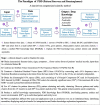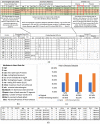Pattern discovery and disentanglement on relational datasets
- PMID: 33707478
- PMCID: PMC7952710
- DOI: 10.1038/s41598-021-84869-4
Pattern discovery and disentanglement on relational datasets
Abstract
Machine Learning has made impressive advances in many applications akin to human cognition for discernment. However, success has been limited in the areas of relational datasets, particularly for data with low volume, imbalanced groups, and mislabeled cases, with outputs that typically lack transparency and interpretability. The difficulties arise from the subtle overlapping and entanglement of functional and statistical relations at the source level. Hence, we have developed Pattern Discovery and Disentanglement System (PDD), which is able to discover explicit patterns from the data with various sizes, imbalanced groups, and screen out anomalies. We present herein four case studies on biomedical datasets to substantiate the efficacy of PDD. It improves prediction accuracy and facilitates transparent interpretation of discovered knowledge in an explicit representation framework PDD Knowledge Base that links the sources, the patterns, and individual patients. Hence, PDD promises broad and ground-breaking applications in genomic and biomedical machine learning.
Conflict of interest statement
The authors declare no competing interests.
Figures





Similar articles
-
Theory and rationale of interpretable all-in-one pattern discovery and disentanglement system.NPJ Digit Med. 2023 May 22;6(1):92. doi: 10.1038/s41746-023-00816-9. NPJ Digit Med. 2023. PMID: 37217691 Free PMC article.
-
Benchmarking Interpretability in Healthcare Using Pattern Discovery and Disentanglement.Bioengineering (Basel). 2025 Mar 18;12(3):308. doi: 10.3390/bioengineering12030308. Bioengineering (Basel). 2025. PMID: 40150773 Free PMC article.
-
Explanation and prediction of clinical data with imbalanced class distribution based on pattern discovery and disentanglement.BMC Med Inform Decis Mak. 2021 Jan 9;21(1):16. doi: 10.1186/s12911-020-01356-y. BMC Med Inform Decis Mak. 2021. PMID: 33422088 Free PMC article.
-
Pattern Discovery and Disentanglement for Aligned Pattern Cluster Analysis and Protein Binding Complexes Detection.In: Helder I. N, editor. Bioinformatics [Internet]. Brisbane (AU): Exon Publications; 2021 Mar 20. Chapter 10. In: Helder I. N, editor. Bioinformatics [Internet]. Brisbane (AU): Exon Publications; 2021 Mar 20. Chapter 10. PMID: 33877769 Free Books & Documents. Review.
-
Machine learning for radiation outcome modeling and prediction.Med Phys. 2020 Jun;47(5):e178-e184. doi: 10.1002/mp.13570. Med Phys. 2020. PMID: 32418338 Review.
Cited by
-
AI illuminates paths in oral cancer: transformative insights, diagnostic precision, and personalized strategies.EXCLI J. 2024 Sep 3;23:1091-1116. doi: 10.17179/excli2024-7253. eCollection 2024. EXCLI J. 2024. PMID: 39391057 Free PMC article. Review.
-
Theory and rationale of interpretable all-in-one pattern discovery and disentanglement system.NPJ Digit Med. 2023 May 22;6(1):92. doi: 10.1038/s41746-023-00816-9. NPJ Digit Med. 2023. PMID: 37217691 Free PMC article.
-
Benchmarking Interpretability in Healthcare Using Pattern Discovery and Disentanglement.Bioengineering (Basel). 2025 Mar 18;12(3):308. doi: 10.3390/bioengineering12030308. Bioengineering (Basel). 2025. PMID: 40150773 Free PMC article.
-
An Unsupervised Error Detection Methodology for Detecting Mislabels in Healthcare Analytics.Bioengineering (Basel). 2024 Jul 31;11(8):770. doi: 10.3390/bioengineering11080770. Bioengineering (Basel). 2024. PMID: 39199728 Free PMC article.
References
-
- Voosen, P. How AI detectives are cracking open the black box of deep learning. Science. https://www.sciencemag.org/news/2017/07/how-ai-detectives-are-cracking-o... (2017).
-
- Samek, W., Wiegand, T. & Müller, K. Explainable artificial intelligence: Understanding, visualizing and interpreting deep learning models. arXiv preprint, arXiv:1708.08296 (2017).
-
- Aggarwal, C. & Sathe, S. Bias reduction in outlier ensembles: the guessing game. In Outlier Ensembles (Springer, 2017). 10.1007/978-3-319-54765-7_4
-
- Napierala K, Stefanowski J. Types of minority class examples and their influence on learning classifiers from imbalanced data. J. Intell. Inf. Syst. 2016;46(3):563–597. doi: 10.1007/s10844-015-0368-1. - DOI
Publication types
LinkOut - more resources
Full Text Sources
Other Literature Sources

